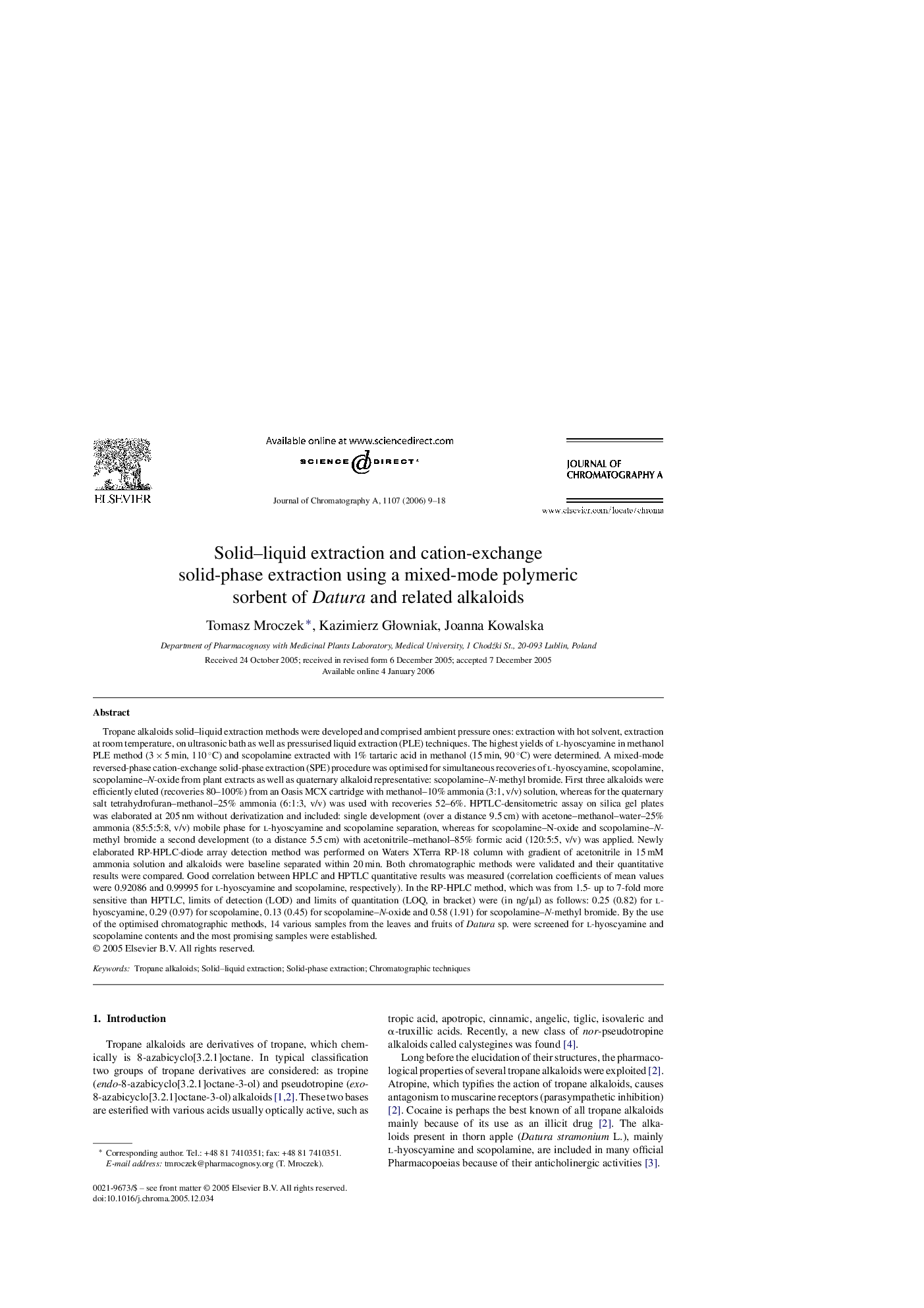| کد مقاله | کد نشریه | سال انتشار | مقاله انگلیسی | نسخه تمام متن |
|---|---|---|---|---|
| 1211634 | 1493774 | 2006 | 10 صفحه PDF | دانلود رایگان |

Tropane alkaloids solid–liquid extraction methods were developed and comprised ambient pressure ones: extraction with hot solvent, extraction at room temperature, on ultrasonic bath as well as pressurised liquid extraction (PLE) techniques. The highest yields of l-hyoscyamine in methanol PLE method (3 × 5 min, 110 °C) and scopolamine extracted with 1% tartaric acid in methanol (15 min, 90 °C) were determined. A mixed-mode reversed-phase cation-exchange solid-phase extraction (SPE) procedure was optimised for simultaneous recoveries of l-hyoscyamine, scopolamine, scopolamine–N-oxide from plant extracts as well as quaternary alkaloid representative: scopolamine–N-methyl bromide. First three alkaloids were efficiently eluted (recoveries 80–100%) from an Oasis MCX cartridge with methanol–10% ammonia (3:1, v/v) solution, whereas for the quaternary salt tetrahydrofuran–methanol–25% ammonia (6:1:3, v/v) was used with recoveries 52–6%. HPTLC-densitometric assay on silica gel plates was elaborated at 205 nm without derivatization and included: single development (over a distance 9.5 cm) with acetone–methanol–water–25% ammonia (85:5:5:8, v/v) mobile phase for l-hyoscyamine and scopolamine separation, whereas for scopolamine–N-oxide and scopolamine–N-methyl bromide a second development (to a distance 5.5 cm) with acetonitrile–methanol–85% formic acid (120:5:5, v/v) was applied. Newly elaborated RP-HPLC-diode array detection method was performed on Waters XTerra RP-18 column with gradient of acetonitrile in 15 mM ammonia solution and alkaloids were baseline separated within 20 min. Both chromatographic methods were validated and their quantitative results were compared. Good correlation between HPLC and HPTLC quantitative results was measured (correlation coefficients of mean values were 0.92086 and 0.99995 for l-hyoscyamine and scopolamine, respectively). In the RP-HPLC method, which was from 1.5- up to 7-fold more sensitive than HPTLC, limits of detection (LOD) and limits of quantitation (LOQ, in bracket) were (in ng/μl) as follows: 0.25 (0.82) for l-hyoscyamine, 0.29 (0.97) for scopolamine, 0.13 (0.45) for scopolamine–N-oxide and 0.58 (1.91) for scopolamine–N-methyl bromide. By the use of the optimised chromatographic methods, 14 various samples from the leaves and fruits of Datura sp. were screened for l-hyoscyamine and scopolamine contents and the most promising samples were established.
Journal: Journal of Chromatography A - Volume 1107, Issues 1–2, 24 February 2006, Pages 9–18